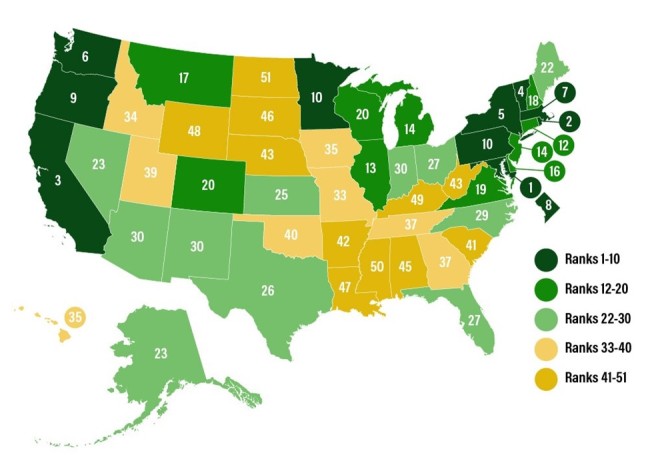Washington, DC—Amid an affordable housing shortage across much of the United States, new research finds most states are not doing nearly enough to support healthy, affordable, decarbonized housing for the most vulnerable families. A first-of-its-kind scorecard from the American Council for an Energy-Efficient Economy (ACEEE) evaluates each state across 33 possible actions to reduce pollution and housing costs for residents through energy efficiency, electrification, and renewable energy investments.
ACEEE’s Pathways to Healthy, Affordable, Decarbonized Housing: A State Scorecard evaluates states on policies such as incentives for low-income households to install solar panels, prioritizing health and safety repairs in home weatherization initiatives, and protecting customers behind on utility bills from shutoffs if they apply to participate in energy efficiency programs.
Maryland performed the best, tallying 54.5 points out of 100 available, followed by Rhode Island with 54 points and California scoring 52 points. No other states earned more than half of the available points.
“Our research shows that states need to enact much stronger policies and significantly expand investments to enable people with low incomes to live in healthy, affordable, decarbonized homes. States have a tremendous opportunity to improve people's daily lives with energy upgrades in homes, but we haven't seen enough states stepping up,” said Sara Hayes, lead author of the report and director of ACEEE’s health and environment program.
The Scorecard reviews five policy areas, with 20 points available for each:
- Energy utilities: The Scorecard reports that 41 states and the District of Columbia have policies encouraging utilities to provide more efficiency programs for low-income households, despite their sometimes higher cost. The report finds that Washington State is the only state to prohibit utility shutoffs between November and March for households who demonstrate their inability to pay and apply for low-income weatherization and home energy assistance. This has the short-term benefit of keeping the homes heated during the cold winter months and the long-term benefit of harnessing weatherization to lower utility bills and thus make nonpayment less likely.
- Weatherization and energy cost assistance: The research shows 25 states and the District of Columbia supplement the federal Weatherization Assistance Program (WAP) with state funds, allowing more households to be served. Colorado is the only state that currently leverages WAP money to integrate solar energy for low-income households.
- State housing policies: State housing finance agencies in New York and California are leading in this area, with strong support for both electrification and energy efficiency for affordable housing residents, which can lower utility bills. Only four other states—Connecticut, Maine, Rhode Island, and Vermont—scored points for incentivizing electrification. Electrifying affordable housing is important because it eliminates indoor combustion of fossil fuels, yielding health and safety benefits, especially for people with respiratory conditions.
- Healthy homes and communities: Maryland scored best because of its remediation of health and safety threats through home repairs. It devotes 20% of its WAP spending to health and safety services. Maryland's Children's Health Insurance Program funds in-home services that remediate lead and asthma triggers. Wisconsin has established multiple programs and funding sources to make home repairs to address health and safety hazards that prevent families from receiving weatherization services, which can reduce triggers for asthma and other respiratory diseases.
- Cross-agency coordination, community engagement, and statewide standards: The District of Columbia is a leader in adopting building energy performance standards for multifamily buildings, which require owners of inefficient buildings to make upgrades. Maine, Massachusetts, Missouri, Pennsylvania, and Rhode Island were the only states to score points for implementing policies to support community engagement in efficiency programs.
Six of the 10 lowest-ranked states lead the nation for the highest percentages of families living in poverty. The poverty levels in these states (Mississippi, Louisiana, West Virginia, Arkansas, Alabama, and Kentucky) mean that implementing the policies outlined in the Scorecard could be particularly impactful.



